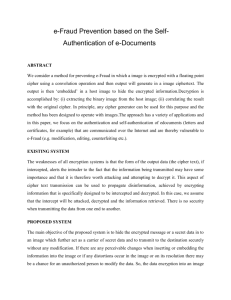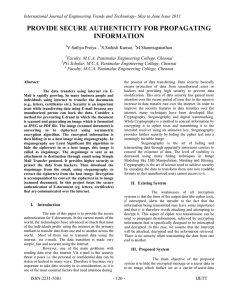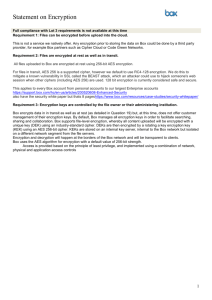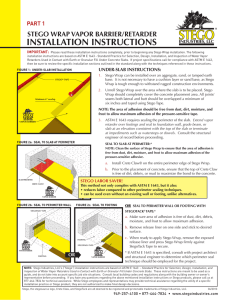Abstract - JP InfoTech
advertisement
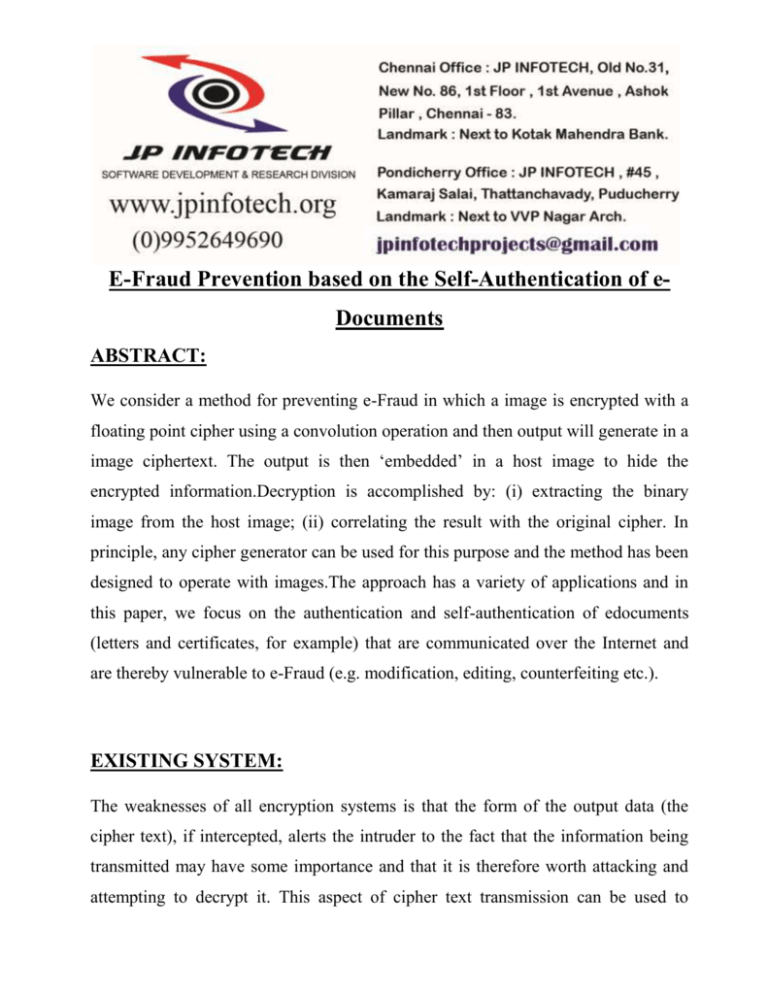
E-Fraud Prevention based on the Self-Authentication of eDocuments ABSTRACT: We consider a method for preventing e-Fraud in which a image is encrypted with a floating point cipher using a convolution operation and then output will generate in a image ciphertext. The output is then ‘embedded’ in a host image to hide the encrypted information.Decryption is accomplished by: (i) extracting the binary image from the host image; (ii) correlating the result with the original cipher. In principle, any cipher generator can be used for this purpose and the method has been designed to operate with images.The approach has a variety of applications and in this paper, we focus on the authentication and self-authentication of edocuments (letters and certificates, for example) that are communicated over the Internet and are thereby vulnerable to e-Fraud (e.g. modification, editing, counterfeiting etc.). EXISTING SYSTEM: The weaknesses of all encryption systems is that the form of the output data (the cipher text), if intercepted, alerts the intruder to the fact that the information being transmitted may have some importance and that it is therefore worth attacking and attempting to decrypt it. This aspect of cipher text transmission can be used to propagate disinformation, achieved by encrypting information that is specifically designed to be intercepted and decrypted. In this case, we assume that the intercept will be attacked, decrypted and the information retrieved. There is no security when transmitting the data from one end to another. PROPOSED SYSTEM: The main objective of the proposed system is to hide the encrypted message or a secret data in to an image which further act as a carrier of secret data and to transmit to the destination securely without any modification. If there are any perceivable changes when inserting or embedding the information into the image or if any distortions occur in the image or on its resolution there may be a chance for an unauthorized person to modify the data. So, the data encryption into an image and decryption and steganography is used to protect the data from unauthorized person, this plays a major role in the project.The scheme allows for the authentication and selfauthentication of documents such as letters, certificates and other image based data. For example, the self-authentication of edocuments sent as attachments over the internet provides a unique facility for many legal and financial transactions that have traditionally relied on paper based documents to secure authenticity. PROCESS FLOW: MODULES: File Upload And Encryption Hiding Text Text Extraction Decryption MODULES DESCRIPTION: 1. File Upload And Encryption: Admin upload the files using filename and fileid. The user will search the uploaded files and select file and send request to admin. Admin view the user requested file and send secret key with image in which text embed into the image .The binary image should be converted in to block of bytes using serialization. The key will encrypt using an encryption algorithm. Use the encryption function to encrypt the numeric plaintext values using the public key. The encrypted function gives an integer value, and then converts the integer value in to hexadecimal value. Concatenate the hexadecimal value to form a cipher text. 2. Hiding Text: Steganography is the process of hiding the one information in to other sources of information like text, image or audio file so that it is not visible to the natural view. Here, the image is encrypted, then encrypted information hidden in a host image It is a simple approach to embedding a message in to the image. The Least Significant Bit insertion varies according to number of bits in an image. The encrypted text is hiding in changed to the bit of secret message. The encrypted information is hidden in a cover image is called as stegoimage. The stego key is used to extract the hidden data from a stegoimage. The stego key is a secret key used to protect the hidden message in an image. The stegoimage should be sent as an attachment to destination. 3. Text Extraction: The stegoimage can view using the image upload path. The hidden text is extracted from the host image using a stego key. The stego key is used to extract the text from the image. The stego key finds the text hidden in image file. Extract the text from an image; finally get the secret data and the hidden message stored in a file. 4. Decryption: The encrypted information extract from an image and using a private key to decrypt the hiddenmessage. Break the ciphertext into small blocks of data that are the same length as the public key modulus. The blocks of data containing a hexadecimal string. The interpret each hexadecimal string as a decimal integer value. Use the decryption function to decrypt the integer values using the private key. Represent each decrypted value as a pair of bytes. By using decryption the ciphertext convert in to block of bytes .After decryption the bytes converted in to binary image using deserialization. The binary image is converted in to image by using dequantization. SYSTEM REQUIREMENTS: HARDWARE REQUIREMENTS: • System : Pentium IV 2.4 GHz. • Hard Disk : 40 GB. • Floppy Drive : 1.44 Mb. • Monitor : 15 VGA Colour. • Mouse : Logitech. • Ram : 512 Mb. SOFTWARE REQUIREMENTS: • Operating system : - Windows XP. • Coding Language : JAVA
